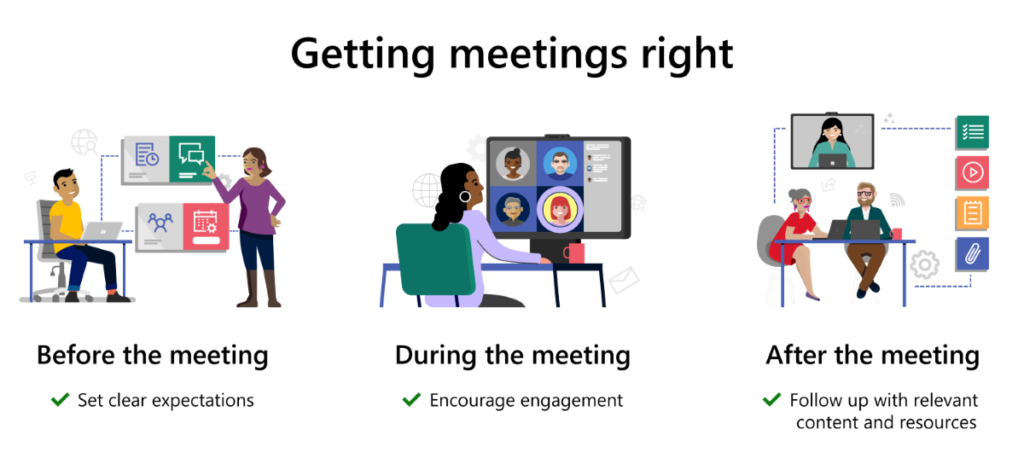 At her core, Susan Sims is a relationship builder. In her work as a senior program manager on the Portfolio Integration team, she has prioritized running inclusive and effective meetings.
At her core, Susan Sims is a relationship builder. In her work as a senior program manager on the Portfolio Integration team, she has prioritized running inclusive and effective meetings.
It was a task made even more crucial in the wake of the global pandemic and the company’s transition to a hybrid working model. With the flexibility for employees to choose between on-campus and remote work, Sims saw an opportunity to enhance meeting experiences by taking advantage of the latest features in Microsoft Teams.
“We rely on meetings to build and maintain relationships, but we’ve had to adapt our workflows to support remote work and back-to-back meetings,” Sims says. “I want to make sure that everyone’s voices are heard.”

As part of efforts at Microsoft to empower hybrid work, Sara Bush, a principal PM manager on the Seamless Teamwork team within Microsoft Digital, led a research-driven initiative to develop guidance for running inclusive meetings. The aim was to provide employees with the tools and knowledge to fully participate and contribute, regardless of their work location.
“Inclusive meetings are the cornerstone of an effective hybrid work culture,” Bush says. “We want every employee to feel valued and empowered to engage from anywhere.”
We’ve learned a lot by listening to our employees—it’s been important to hear directly from them.
“Teams Meeting Recap plays a pivotal role in asynchronous inclusion by providing insights to all the meeting content and relevant documents both before and after a meeting. Along with AI generated notes from the meeting recording” says Sims.
Our research-based guide outlines key elements of an inclusive and effective meeting, emphasizing access to relevant documents, content, and participants before, during, and after the session. To make it easier for teams to follow these principles, Microsoft Teams now offers pre-made templates that can be customized to fit various meeting types, ensuring a consistent and inclusive experience for all attendees.
A significant aspect of inclusivity in meetings is ensuring that everyone can engage with the content effectively. Microsoft Teams addresses this by introducing live captions and translations of the captions during meetings, making it more accessible for all attendees and easier for everyone to participate and contribute meaningfully.
The Microsoft Teams live captions translation feature opens the doors for employees from every corner of the world to actively take part in meetings using the language they’re most comfortable with, allowing everyone to contribute and engage fully, no matter what language they prefer.
“Inclusion is defined by the ability to feel comfortable contributing their ideas and perspectives,” Bush says.
Chanda Jensen, senior product manager in Microsoft Digital who worked with Bush to compile a research-based guide to running inclusive and effective meetings, saw a lot of value in putting these best practices in one place. “We don’t need to reinvent the wheel on guidance for running effective meetings,” Jensen says. “We want people to go back to the basics, so we created a dynamic resource that we’ll update as features or guidance changes.”
The impact of inclusive meetings extends beyond the virtual meeting room. With the adoption of these best practices, teams across Microsoft have experienced increased collaboration and improved productivity. Employees now readily share their insights and suggestions, fostering a culture of active participation and mutual support.
“The response from employees has been great,” says Laura Oxford, a senior content program manager who works with Bush and Jensen. “When we share the latest features or guidance on Viva Engage, we hear from people who are using these best practices to successfully support asynchronous collaboration, which is more and more important for our global workforce.”

Sims, inspired by the meeting guide and the innovative features in Microsoft Teams, has seen tremendous success in creating a positive and inclusive meeting experience for her team. She ensures live transcripts and captions are available and encourages team members to express themselves through avatars, strengthening the sense of unity and engagement within her team.
“The meeting guide helped me get the basics right and take small steps to ensure that meetings are inclusive for everyone,” Sims says. “For example, one of the suggestions is to start meetings five minutes past the hour to reduce meeting fatigue and give people a break from back-to-back meetings. And if you’re in a meeting with someone who needs guidance, you can invite people to check out the meeting guide and incorporate some of the tips.”
One small change that Sims is making?
She’s been scheduling virtual coffee chats with new employees on her team, which Microsoft Teams has been a core part of.
“I recognize how challenging it is to build an inclusive team when we can’t sit down and meet face to face to build trust,” Sims says. “That’s why we’ve been using Microsoft Teams as a tool to connect regularly.”
Find out how Microsoft enables its employees to work remotely with Microsoft Teams.
Microsoft Teams features support inclusive meetings
It’s easy to think of a meeting as just the time of the call itself. In reality, meetings aren’t just a point in time—there’s a before, during, and after, and Sims sets expectations for each call, manages roles and access, and follows up with decisions and outcomes.
“If I own the agenda for a meeting, I always try to clarify the purpose of the call,” Sims says. “The reality is that we’re in so many back-to-back meetings, so we need to remind people at the beginning of the goal and intent of the meeting.”

Bush says that there are crucial steps everyone can take to make meetings more inclusive. For example, it’s important to drop an agenda into every meeting invitation.
“Using an agenda can help attendees identify if they need to attend or join asynchronously by watching the recording or reviewing outcomes later, freeing them up from back-to-back meetings so they can focus on the highest impact work,” Bush says.
[Teams] features like hand-raising or reactions with emojis ensure that employees can communicate their ideas and emotions with others.
—Chanda Jensen, senior product manager in Microsoft Digital
Bush defined six meeting categories, or archetypes, that are common at Microsoft: status, strategic, tactical, informative, ideation, and social. For each meeting type, the meeting guide outlines a recommended duration, number of attendees, and guidance on how to keep attendees engaged using interactive features in Teams.
Bush says that the team landed on these archetypes based on industry research and data on meetings at Microsoft, and new Teams features that can help make the meeting experience more engaging. For example, the addition of the raise your hand feature enables any attendee to signal that they have a thought or question.
“Features like hand-raising or reactions with emojis or their avatars ensure that employees can communicate their ideas and emotions with others,” Jensen says. “We also encourage meeting organizers to establish norms at the beginning for how to engage in the meeting, and even assign a moderator to watch for raised hands and chat messages and invite people to chime in.”
For a transcript, please view the video on YouTube: https://www.youtube.com/watch?v=eTCUALH6PtU, select the “More actions” button (three dots icon) below the video, and then select “Show transcript.”Microsoft Teams Avatars have emerged as an innovative and inclusive feature within Microsoft Teams. These customizable digital representations allow individuals to express themselves visually, making meetings more engaging and fostering a sense of belonging, particularly for remote team members. Additionally, avatars are designed to be accessible to users with diverse abilities, promoting a truly inclusive experience for everyone.
“It also helps to pick whichever meeting view keeps you focused, whether it’s together mode, large gallery, or side-by-side view of a presentation and the presenter,” Bush says. “You can also turn on live transcriptions and record the meeting for people who can’t attend or want to review the content later.”
Meetings don’t have to look alike. Pick the meeting type and approach that feels authentic to your leadership style, while working these best practices in.
—Susan Sims, senior program manager on the Portfolio Integration team
Transitioning to a digital workplace
As Microsoft embraces a hybrid workplace with flexible working styles, Bush is committed to ensuring that all employees can fully engage in meetings, regardless of their physical location—be it at the office, on the road, or working from home.
“Meeting organizers can make small changes to ensure that employees who are located in or out of a meeting room will feel included,” Bush says. “A crucial best practice for hybrid meetings is to embrace asynchronous or flexible work styles. This allows participants to join the Teams meeting when it best suits their schedule and availability. By providing meeting recap, live transcriptions, and collaboration tools, we empower employees to contribute and engage in discussions, regardless of whether they attend the meeting in real-time or catch up later. ”
Embracing the transformative nature of hybrid work, Bush is passionate about her daily efforts to ensure that every individual feels valued and included in the meeting process, regardless of their preferred work style. Given the shift to a hybrid work model at Microsoft, the research-driven approach has enabled the company to identify precisely what employees need to thrive in these collaborative settings.
“Meetings don’t need to conform to a one-size-fits-all model,” Sims emphasizes. “Leaders should feel empowered to select meeting types and approaches that align with their authentic leadership styles while incorporating these valuable best practices. By embracing asynchronous or flexible work styles, we create an inclusive environment that fosters creativity, productivity, and work-life balance for all team members.”
As Microsoft continues to champion flexible work in the hybrid workplace, the focus remains on empowering employees to work seamlessly from any location. By providing the right tools, guidance, and features like pre-made templates, live transcripts, and avatars, Microsoft Teams is revolutionizing the way teams collaborate, ushering in a new era of inclusive and efficient meetings in the hybrid workplace.

- Embrace Asynchronous Collaboration: Support your team to adopt asynchronous work styles and take advantage of the Microsoft Teams collaboration tools. Provide meeting recordings, transcriptions, and share relevant documents in advance so that participants can contribute and engage at their convenience, regardless of their location or time zone.
- Utilize Inclusive Teams Features: Prioritize inclusivity in meetings by making the most of inclusive features provided by Microsoft Teams. Enable captions in the Teams settings and live transcripts during meetings to accommodate all participants and encourage the use of avatars to foster a sense of belonging and self-expression among team members.
- Customize Meeting Formats: Empower meeting organizers to tailor meeting formats to suit their team’s preferred collaboration style. Utilize pre-made templates in Microsoft Teams to ensure consistency and inclusivity across various meeting types, while adapting the approach to align with your leadership style and team dynamics.

- Read this guide from Microsoft Research about how to intentionally run remote meetings.
- Find out how Microsoft enables its employees to work remotely with Microsoft Teams.
- Explore how Microsoft employees are using Avatars for Meetings.
- Discover teaching Microsoft employees healthy hybrid meeting habits with Minecraft.








